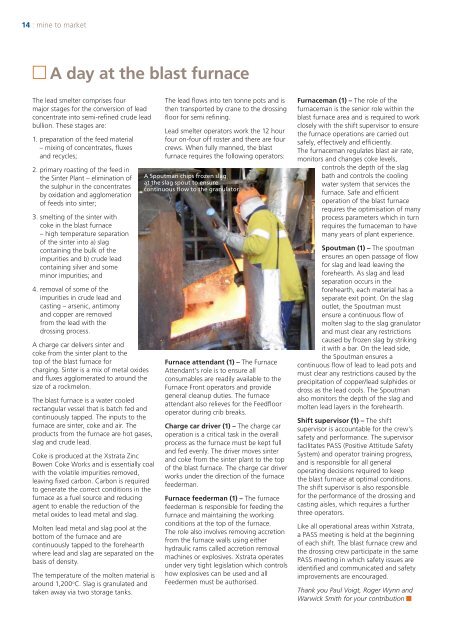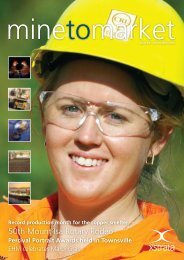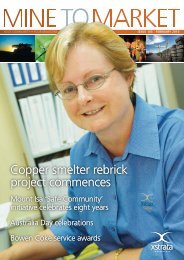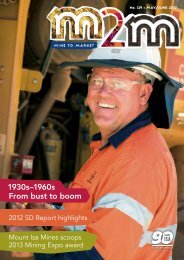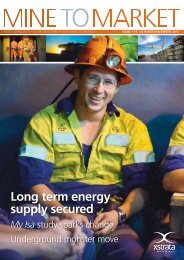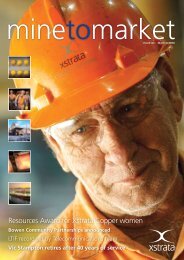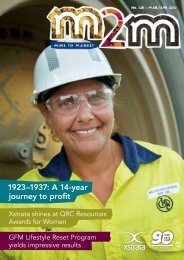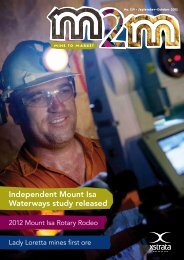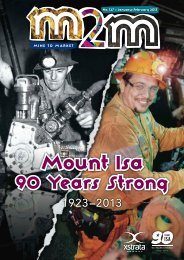Mine to Market - July 2009 - Ernest Henry Mining
Mine to Market - July 2009 - Ernest Henry Mining
Mine to Market - July 2009 - Ernest Henry Mining
You also want an ePaper? Increase the reach of your titles
YUMPU automatically turns print PDFs into web optimized ePapers that Google loves.
14 : mine <strong>to</strong> market<br />
A day at the blast furnace<br />
The lead smelter comprises four<br />
major stages for the conversion of lead<br />
concentrate in<strong>to</strong> semi-refined crude lead<br />
bullion. These stages are:<br />
1. preparation of the feed material<br />
– mixing of concentrates, fluxes<br />
and recycles;<br />
2. primary roasting of the feed in<br />
the Sinter Plant – elimination of<br />
the sulphur in the concentrates<br />
by oxidation and agglomeration<br />
of feeds in<strong>to</strong> sinter;<br />
3. smelting of the sinter with<br />
coke in the blast furnace<br />
– high temperature separation<br />
of the sinter in<strong>to</strong> a) slag<br />
containing the bulk of the<br />
impurities and b) crude lead<br />
containing silver and some<br />
minor impurities; and<br />
4. removal of some of the<br />
impurities in crude lead and<br />
casting – arsenic, antimony<br />
and copper are removed<br />
from the lead with the<br />
drossing process.<br />
A charge car delivers sinter and<br />
coke from the sinter plant <strong>to</strong> the<br />
<strong>to</strong>p of the blast furnace for<br />
charging. Sinter is a mix of metal oxides<br />
and fluxes agglomerated <strong>to</strong> around the<br />
size of a rockmelon.<br />
The blast furnace is a water cooled<br />
rectangular vessel that is batch fed and<br />
continuously tapped. The inputs <strong>to</strong> the<br />
furnace are sinter, coke and air. The<br />
products from the furnace are hot gases,<br />
slag and crude lead.<br />
Coke is produced at the Xstrata Zinc<br />
Bowen Coke Works and is essentially coal<br />
with the volatile impurities removed,<br />
leaving fixed carbon. Carbon is required<br />
<strong>to</strong> generate the correct conditions in the<br />
furnace as a fuel source and reducing<br />
agent <strong>to</strong> enable the reduction of the<br />
metal oxides <strong>to</strong> lead metal and slag.<br />
Molten lead metal and slag pool at the<br />
bot<strong>to</strong>m of the furnace and are<br />
continuously tapped <strong>to</strong> the forehearth<br />
where lead and slag are separated on the<br />
basis of density.<br />
The temperature of the molten material is<br />
around 1,200 o C. Slag is granulated and<br />
taken away via two s<strong>to</strong>rage tanks.<br />
The lead flows in<strong>to</strong> ten <strong>to</strong>nne pots and is<br />
then transported by crane <strong>to</strong> the drossing<br />
floor for semi refining.<br />
Lead smelter opera<strong>to</strong>rs work the 12 hour<br />
four on-four off roster and there are four<br />
crews. When fully manned, the blast<br />
furnace requires the following opera<strong>to</strong>rs:<br />
A Spoutman chips frozen slag<br />
at the slag spout <strong>to</strong> ensure<br />
continuous flow <strong>to</strong> the granula<strong>to</strong>r.<br />
Furnace attendant (1) – The Furnace<br />
Attendant’s role is <strong>to</strong> ensure all<br />
consumables are readily available <strong>to</strong> the<br />
Furnace Front opera<strong>to</strong>rs and provide<br />
general cleanup duties. The furnace<br />
attendant also relieves for the Feedfloor<br />
opera<strong>to</strong>r during crib breaks.<br />
Charge car driver (1) – The charge car<br />
operation is a critical task in the overall<br />
process as the furnace must be kept full<br />
and fed evenly. The driver moves sinter<br />
and coke from the sinter plant <strong>to</strong> the <strong>to</strong>p<br />
of the blast furnace. The charge car driver<br />
works under the direction of the furnace<br />
feederman.<br />
Furnace feederman (1) – The furnace<br />
feederman is responsible for feeding the<br />
furnace and maintaining the working<br />
conditions at the <strong>to</strong>p of the furnace.<br />
The role also involves removing accretion<br />
from the furnace walls using either<br />
hydraulic rams called accretion removal<br />
machines or explosives. Xstrata operates<br />
under very tight legislation which controls<br />
how explosives can be used and all<br />
Feedermen must be authorised.<br />
Furnaceman (1) – The role of the<br />
furnaceman is the senior role within the<br />
blast furnace area and is required <strong>to</strong> work<br />
closely with the shift supervisor <strong>to</strong> ensure<br />
the furnace operations are carried out<br />
safely, effectively and efficiently.<br />
The furnaceman regulates blast air rate,<br />
moni<strong>to</strong>rs and changes coke levels,<br />
controls the depth of the slag<br />
bath and controls the cooling<br />
water system that services the<br />
furnace. Safe and efficient<br />
operation of the blast furnace<br />
requires the optimisation of many<br />
process parameters which in turn<br />
requires the furnaceman <strong>to</strong> have<br />
many years of plant experience.<br />
Spoutman (1) – The spoutman<br />
ensures an open passage of flow<br />
for slag and lead leaving the<br />
forehearth. As slag and lead<br />
separation occurs in the<br />
forehearth, each material has a<br />
separate exit point. On the slag<br />
outlet, the Spoutman must<br />
ensure a continuous flow of<br />
molten slag <strong>to</strong> the slag granula<strong>to</strong>r<br />
and must clear any restrictions<br />
caused by frozen slag by striking<br />
it with a bar. On the lead side,<br />
the Spoutman ensures a<br />
continuous flow of lead <strong>to</strong> lead pots and<br />
must clear any restrictions caused by the<br />
precipitation of copper/lead sulphides or<br />
dross as the lead cools. The Spoutman<br />
also moni<strong>to</strong>rs the depth of the slag and<br />
molten lead layers in the forehearth.<br />
Shift supervisor (1) – The shift<br />
supervisor is accountable for the crew’s<br />
safety and performance. The supervisor<br />
facilitates PASS (Positive Attitude Safety<br />
System) and opera<strong>to</strong>r training progress,<br />
and is responsible for all general<br />
operating decisions required <strong>to</strong> keep<br />
the blast furnace at optimal conditions.<br />
The shift supervisor is also responsible<br />
for the performance of the drossing and<br />
casting aisles, which requires a further<br />
three opera<strong>to</strong>rs.<br />
Like all operational areas within Xstrata,<br />
a PASS meeting is held at the beginning<br />
of each shift. The blast furnace crew and<br />
the drossing crew participate in the same<br />
PASS meeting in which safety issues are<br />
identified and communicated and safety<br />
improvements are encouraged.<br />
Thank you Paul Voigt, Roger Wynn and<br />
Warwick Smith for your contribution


